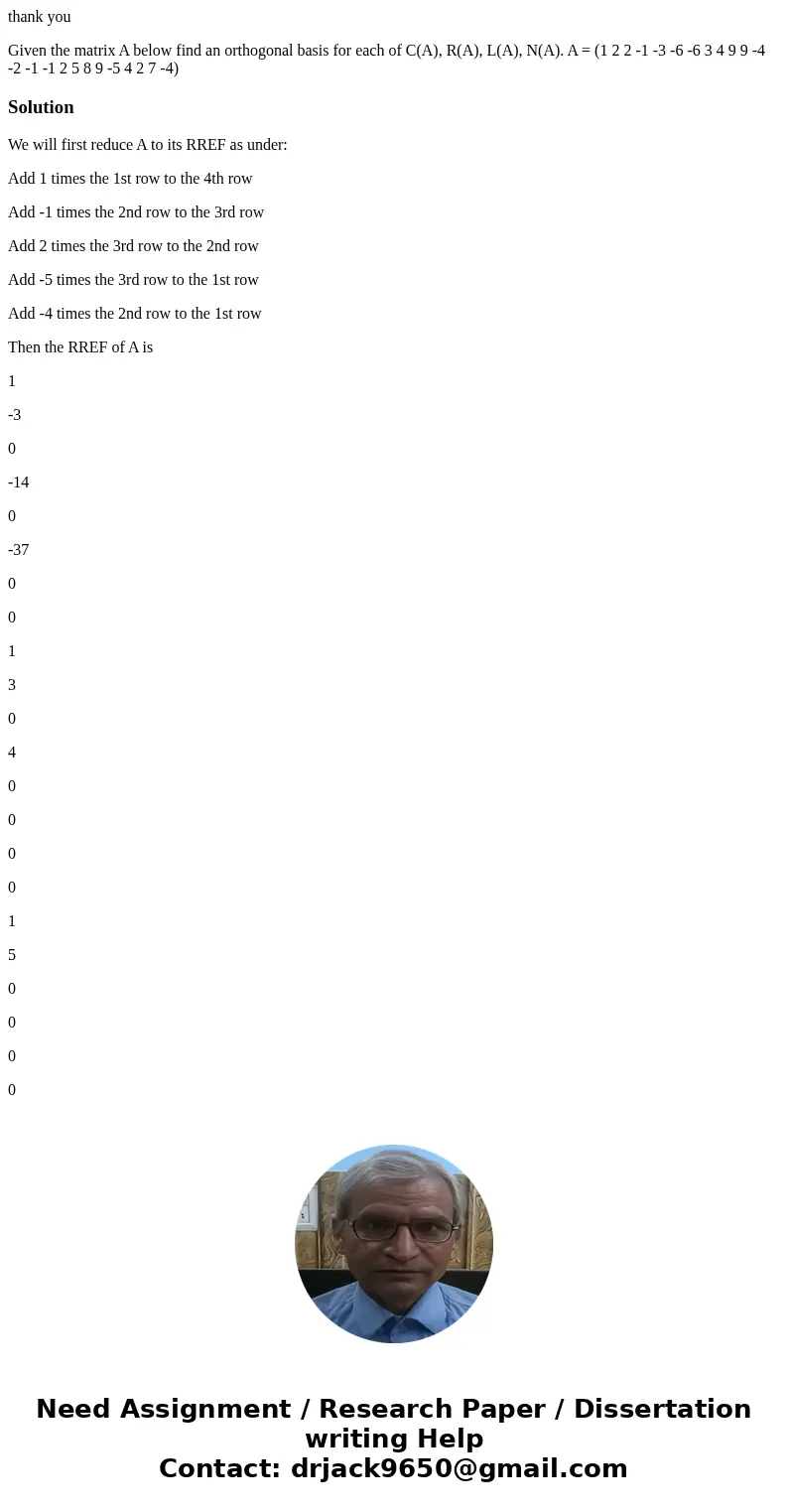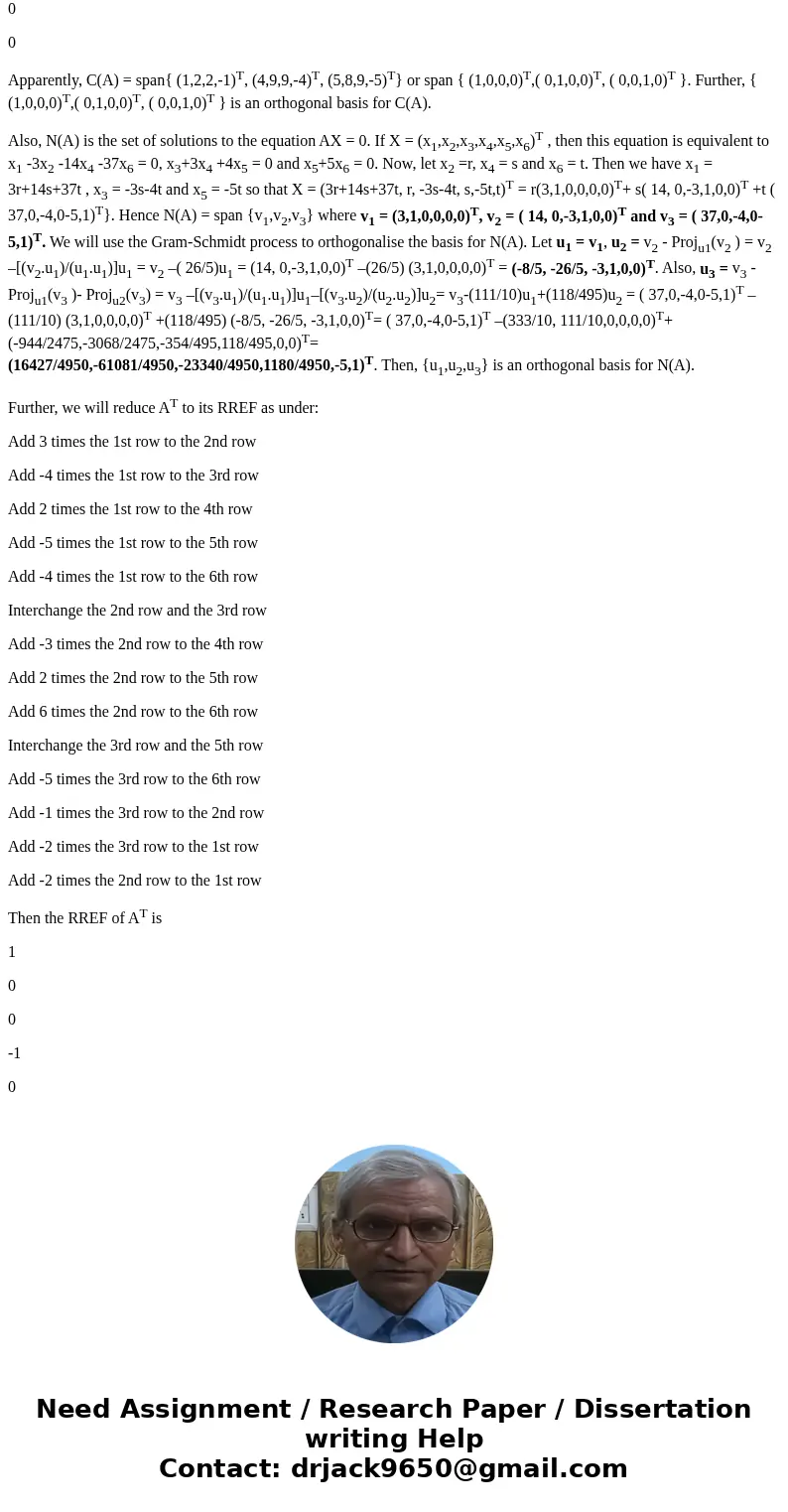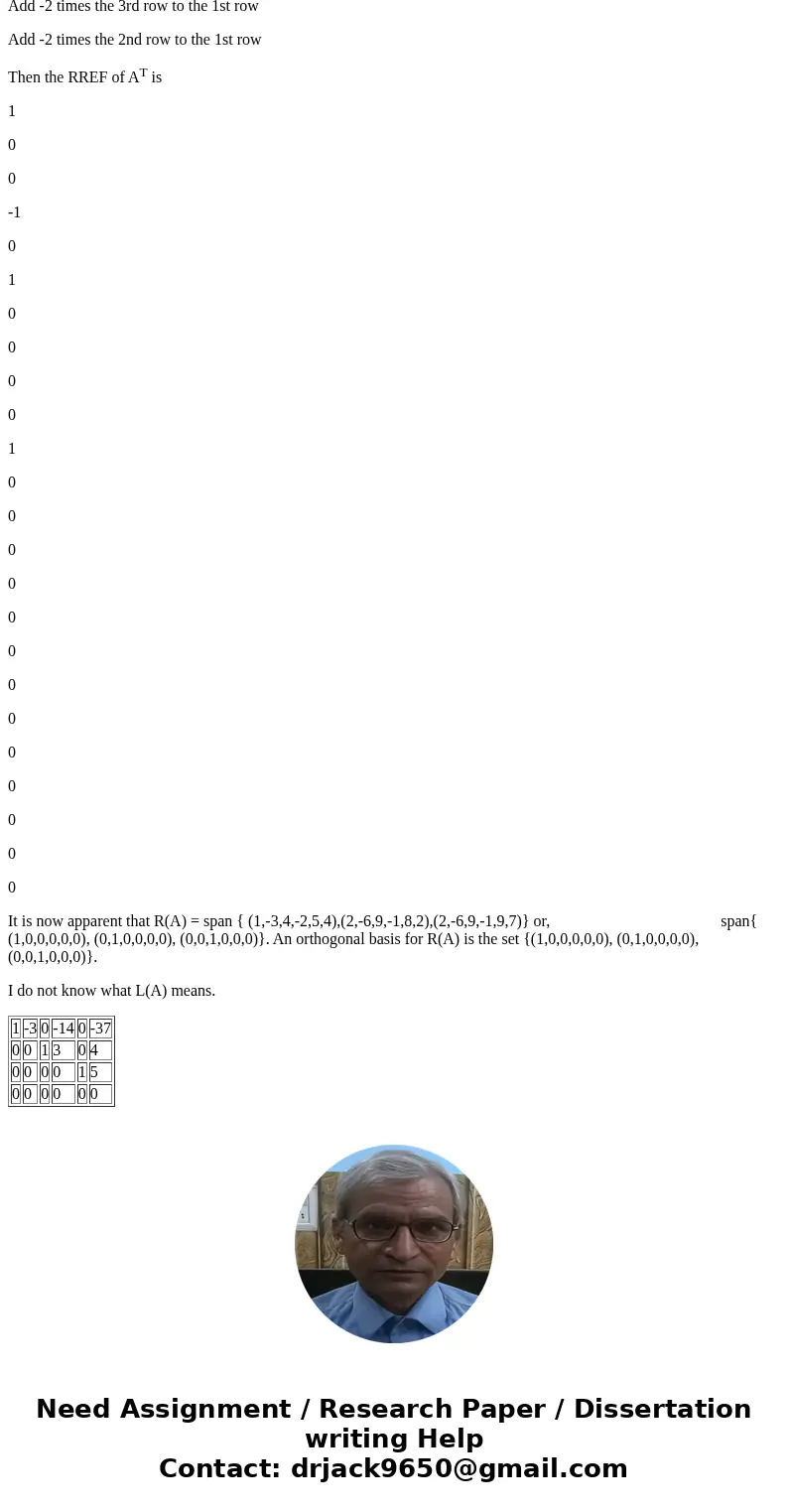thank you Given the matrix A below find an orthogonal basis
thank you
Given the matrix A below find an orthogonal basis for each of C(A), R(A), L(A), N(A). A = (1 2 2 -1 -3 -6 -6 3 4 9 9 -4 -2 -1 -1 2 5 8 9 -5 4 2 7 -4)Solution
We will first reduce A to its RREF as under:
Add 1 times the 1st row to the 4th row
Add -1 times the 2nd row to the 3rd row
Add 2 times the 3rd row to the 2nd row
Add -5 times the 3rd row to the 1st row
Add -4 times the 2nd row to the 1st row
Then the RREF of A is
1
-3
0
-14
0
-37
0
0
1
3
0
4
0
0
0
0
1
5
0
0
0
0
0
0
Apparently, C(A) = span{ (1,2,2,-1)T, (4,9,9,-4)T, (5,8,9,-5)T} or span { (1,0,0,0)T,( 0,1,0,0)T, ( 0,0,1,0)T }. Further, { (1,0,0,0)T,( 0,1,0,0)T, ( 0,0,1,0)T } is an orthogonal basis for C(A).
Also, N(A) is the set of solutions to the equation AX = 0. If X = (x1,x2,x3,x4,x5,x6)T , then this equation is equivalent to x1 -3x2 -14x4 -37x6 = 0, x3+3x4 +4x5 = 0 and x5+5x6 = 0. Now, let x2 =r, x4 = s and x6 = t. Then we have x1 = 3r+14s+37t , x3 = -3s-4t and x5 = -5t so that X = (3r+14s+37t, r, -3s-4t, s,-5t,t)T = r(3,1,0,0,0,0)T+ s( 14, 0,-3,1,0,0)T +t ( 37,0,-4,0-5,1)T}. Hence N(A) = span {v1,v2,v3} where v1 = (3,1,0,0,0,0)T, v2 = ( 14, 0,-3,1,0,0)T and v3 = ( 37,0,-4,0-5,1)T. We will use the Gram-Schmidt process to orthogonalise the basis for N(A). Let u1 = v1, u2 = v2 - Proju1(v2 ) = v2 –[(v2.u1)/(u1.u1)]u1 = v2 –( 26/5)u1 = (14, 0,-3,1,0,0)T –(26/5) (3,1,0,0,0,0)T = (-8/5, -26/5, -3,1,0,0)T. Also, u3 = v3 - Proju1(v3 )- Proju2(v3) = v3 –[(v3.u1)/(u1.u1)]u1–[(v3.u2)/(u2.u2)]u2= v3-(111/10)u1+(118/495)u2 = ( 37,0,-4,0-5,1)T – (111/10) (3,1,0,0,0,0)T +(118/495) (-8/5, -26/5, -3,1,0,0)T= ( 37,0,-4,0-5,1)T –(333/10, 111/10,0,0,0,0)T+ (-944/2475,-3068/2475,-354/495,118/495,0,0)T= (16427/4950,-61081/4950,-23340/4950,1180/4950,-5,1)T. Then, {u1,u2,u3} is an orthogonal basis for N(A).
Further, we will reduce AT to its RREF as under:
Add 3 times the 1st row to the 2nd row
Add -4 times the 1st row to the 3rd row
Add 2 times the 1st row to the 4th row
Add -5 times the 1st row to the 5th row
Add -4 times the 1st row to the 6th row
Interchange the 2nd row and the 3rd row
Add -3 times the 2nd row to the 4th row
Add 2 times the 2nd row to the 5th row
Add 6 times the 2nd row to the 6th row
Interchange the 3rd row and the 5th row
Add -5 times the 3rd row to the 6th row
Add -1 times the 3rd row to the 2nd row
Add -2 times the 3rd row to the 1st row
Add -2 times the 2nd row to the 1st row
Then the RREF of AT is
1
0
0
-1
0
1
0
0
0
0
1
0
0
0
0
0
0
0
0
0
0
0
0
0
It is now apparent that R(A) = span { (1,-3,4,-2,5,4),(2,-6,9,-1,8,2),(2,-6,9,-1,9,7)} or, span{ (1,0,0,0,0,0), (0,1,0,0,0,0), (0,0,1,0,0,0)}. An orthogonal basis for R(A) is the set {(1,0,0,0,0,0), (0,1,0,0,0,0), (0,0,1,0,0,0)}.
I do not know what L(A) means.
| 1 | -3 | 0 | -14 | 0 | -37 |
| 0 | 0 | 1 | 3 | 0 | 4 |
| 0 | 0 | 0 | 0 | 1 | 5 |
| 0 | 0 | 0 | 0 | 0 | 0 |



 Homework Sourse
Homework Sourse